brake sensor SSANGYONG RODIUS 2005 Service Manual
[x] Cancel search | Manufacturer: SSANGYONG, Model Year: 2005, Model line: RODIUS, Model: SSANGYONG RODIUS 2005Pages: 502, PDF Size: 70.43 MB
Page 164 of 502

0-3
DC 5-SPEED AUTOMATIC TRANSMISSION
RODIUS 2005.07
3650-01
2WD 4WD
3650-01DC 5-SPEED AUTOMATIC TRANSMISSION
1. OVERVIEW
DCAG 5-speed automatic transmission is an electronically controlled 5-speed transmission with
a lockup clutch in the torque converter.
The ratios for the gears are realized by three planetary gear sets. The 5th gear is designed with
a step-up ratio of 0.83 as an overdrive. The selector lever is controlled by electronically and
mechanically.
The gears are shifted by the corresponding combination of three hydraulically actuated
multiple-disc brakes, three hydraulically actuated multiple-disc clutches and two mechanical
one-way clutches.
This electronically controlled automatic transmission adjusts the operating pressure to provide
proper shifting in relation to engine power. This function improves shifting quality significantly.
And, the driver can select “S” (Standard) mode or “W” (Winter) mode according to the
driving conditions.
This automatic transmission provides two gears even during reverse driving.
The internal sensors and controls are connected to TCU by cylindrical 13-pin connector.
DCAG 5-speed automatic transmission offers the following advantages ▶
Improved shifting quality
More gears
Extended working life and reliability
Reduced fuel consumption -
-
-
-
Page 235 of 502

0-8
RODIUS 2005.07
4830-01
BRAKS SYSTEM
6) Master Cylider & Booster
ABS system is basically equipped to STAVIC.
Vehicle which adapted ESP system in option has two pressure sensors under master cylinder
and these two sensor are used for BAS (Brake Assist System) system.
Do not disassemble the brake oil pressure sensors These can not be reinstalled of
disassembled.
After reinstall the reserver tank perform a air bleeding of brake system
-
-
Vehicle with ESP Vehicle with ABS
Brake fluid reservoir tank Master cylinder
Page 239 of 502
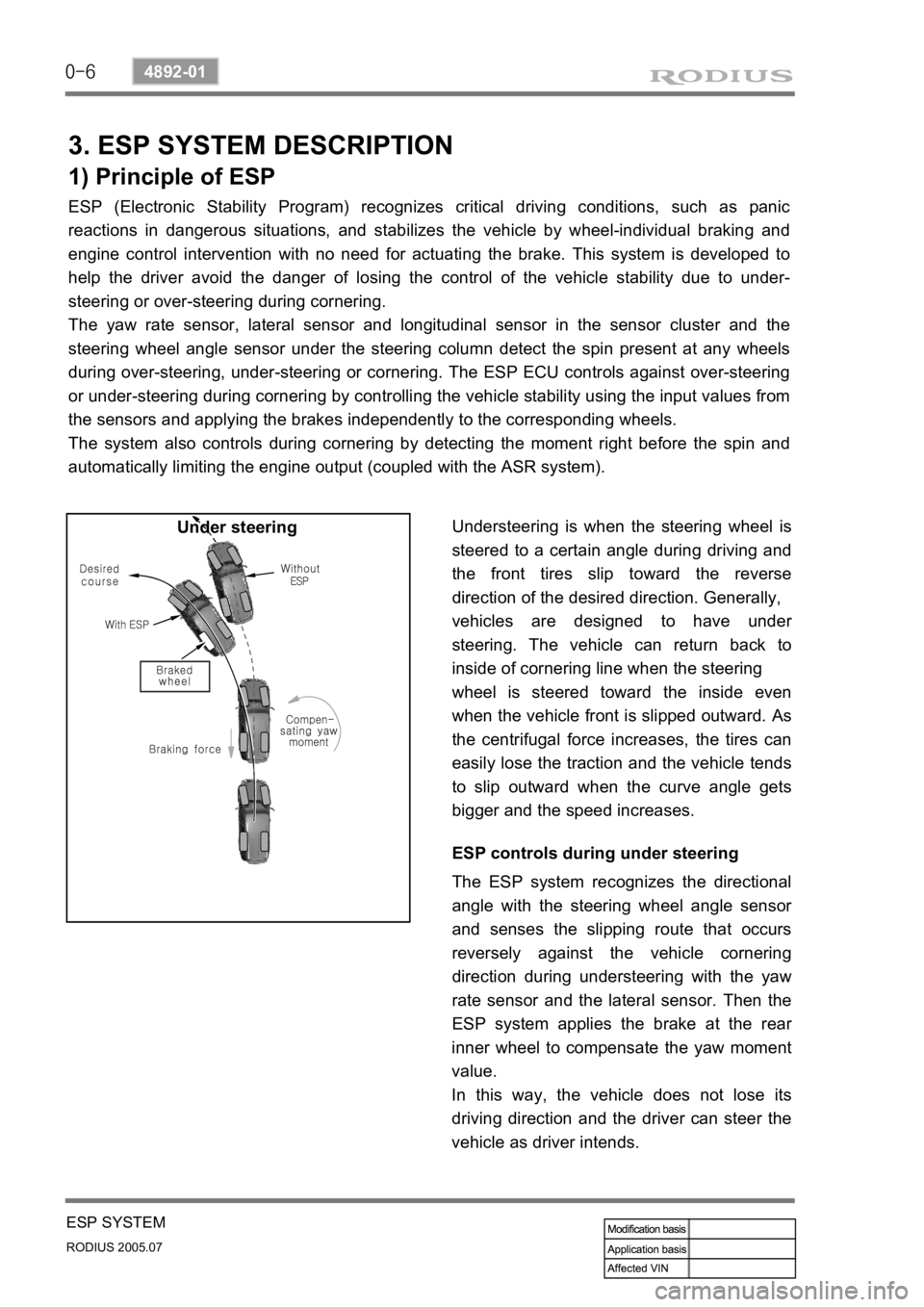
0-6
RODIUS 2005.07
4892-01
ESP SYSTEM
3. ESP SYSTEM DESCRIPTION
1) Principle of ESP
ESP (Electronic Stability Program) recognizes critical driving conditions, such as panic
reactions in dangerous situations, and stabilizes the vehicle by wheel-individual braking and
engine control intervention with no need for actuating the brake. This system is developed to
help the driver avoid the danger of losing the control of the vehicle stability due to under-
steering or over-steering during cornering.
The yaw rate sensor, lateral sensor and longitudinal sensor in the sensor cluster and the
steering wheel angle sensor under the steering column detect the spin present at any wheels
during over-steering, under-steering or cornering. The ESP ECU controls against over-steering
or under-steering during cornering by controlling the vehicle stability using the input values from
the sensors and applying the brakes independently to the corresponding wheels.
The system also controls during cornering by detecting the moment right before the spin and
automatically limiting the engine output (coupled with the ASR system).
Understeering is when the steering wheel is
steered to a certain angle during driving and
the front tires slip toward the reverse
direction of the desired direction. Generally,
vehicles are designed to have unde
r
steering. The vehicle can return back to
inside of cornering line when the steering
wheel is steered toward the inside even
when the vehicle front is slipped outward.
As
the centrifugal force increases, the tires can
easily lose the traction and the vehicle tends
to slip outward when the curve angle gets
bigger and the speed increases. Under steering
ESP controls during under steering
The ESP system recognizes the directional
angle with the steering wheel angle senso
r
and senses the slipping route that occurs
reversely against the vehicle cornering
direction during understeering with the yaw
rate sensor and the lateral sensor. Then the
ESP system applies the brake at the rea
r
inner wheel to compensate the yaw moment
value.
In this way, the vehicle does not lose its
driving direction and the driver can steer the
vehicle as driver intends.
Page 240 of 502

0-7
ESP SYSTEM
RODIUS 2005.07
4892-01
Over steeringOversteering is when the steering wheel is
steered to a certain angle during driving and
the rear tires slip outward losing traction.
When compared with under steering
vehicles, the controlling of the vehicle is
difficult during cornering and the vehicle can
spin due to rear wheel moment when the
rear tires lose traction and the vehicle speed
increases.
ESP controls during oversteering
The ESP system recognizes the directional
angle with the steering wheel angle senso
r
and senses the slipping route that occurs
towards the vehicle cornering direction
during oversteering with the yaw rate senso
r
and the lateral sensor. Then the ESP system
applies the brake at the front outer wheel to
compensate the yaw moment value.
In this way, the vehicle does not lose its
driving direction and the driver can steer the
vehicle as he or she intends.
2) ESP Control
The ESP system includes the ABS/EBD and ASR systems allowing the system to be able to
operate depending to the vehicle driving conditions. For example, when the brakes are applied
during cornering at the speed of 100 km/h, the ABS system will operate at the same time the
ASR or ABD systems operate to reduce the power from the slipping wheel. And when yaw rate
sensor detects the rate exceeding 4¡Æ/seconds, the ESP system is activated to apply the
brake force to the corresponding wheel to compensate the yaw moment with the vehicle
stability control function. When various systems operate simultaneously under a certain
situation, there may be vehicle control problems due to internal malfunction of a system o
r
simultaneous operations. In order to compensate to this problem, the ESP system sets the
priority among systems. The system operates in the order of TCS (ASR or ABD), ESP and
ABS. The order may be changed depending on the vehicle driving situations and driving
conditions. As the single-track vehicle model used for the calculations is only valid for a vehicle
moving forward, ESP intervention never takes place during backup.
Page 241 of 502
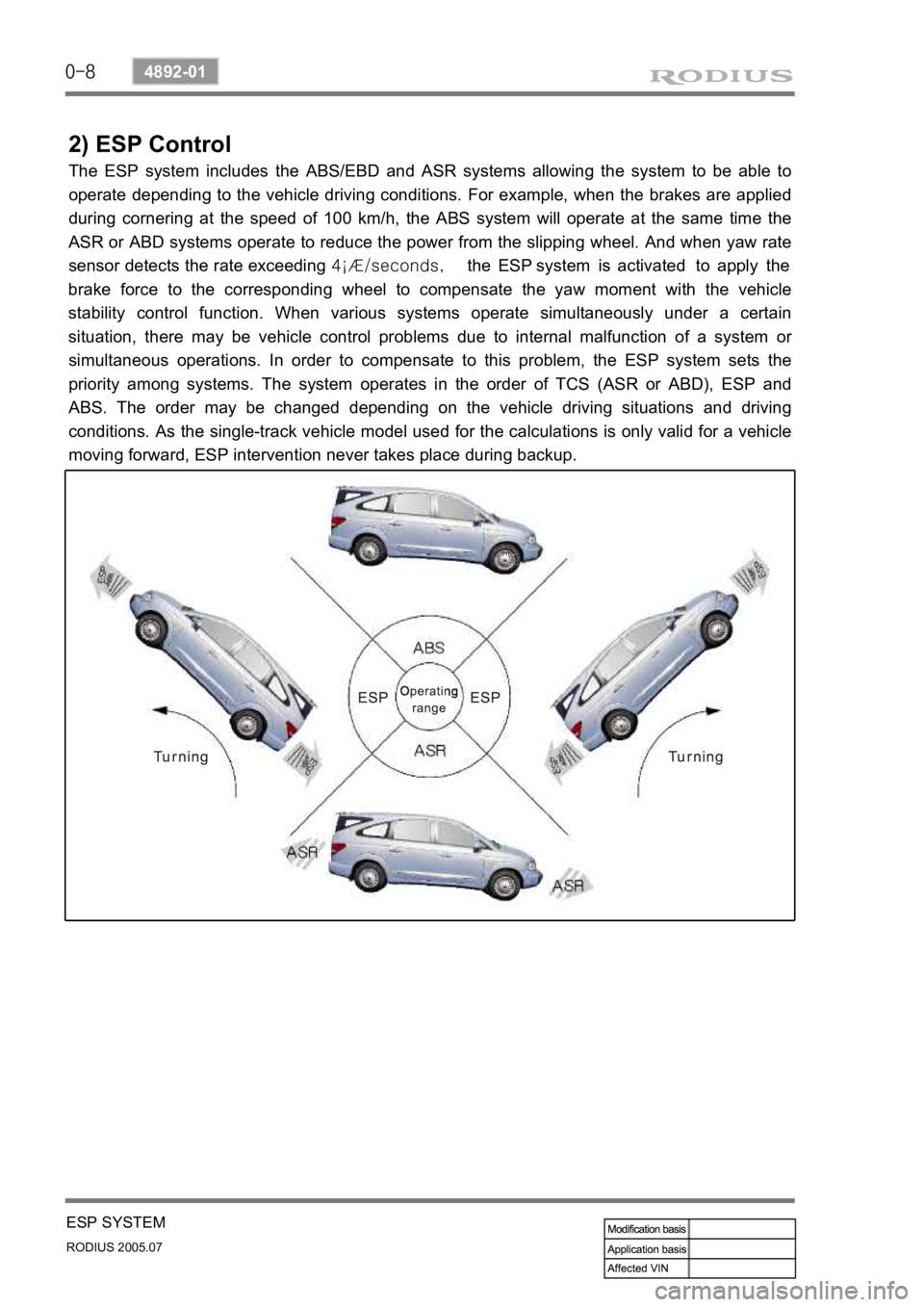
0-8
RODIUS 2005.07
4892-01
ESP SYSTEM
2) ESP Control
The ESP system includes the ABS/EBD and ASR systems allowing the system to be able to
operate depending to the vehicle driving conditions. For example, when the brakes are applied
during cornering at the speed of 100 km/h, the ABS system will operate at the same time the
ASR or ABD systems operate to reduce the power from the slipping wheel. And when yaw rate
sensor detects the rate exceeding 4¡Æ/seconds, the ESP system is activated to apply the
brake force to the corresponding wheel to compensate the yaw moment with the vehicle
stability control function. When various systems operate simultaneously under a certain
situation, there may be vehicle control problems due to internal malfunction of a system o
r
simultaneous operations. In order to compensate to this problem, the ESP system sets the
priority among systems. The system operates in the order of TCS (ASR or ABD), ESP and
ABS. The order may be changed depending on the vehicle driving situations and driving
conditions. As the single-track vehicle model used for the calculations is only valid for a vehicle
moving forward, ESP intervention never takes place during backup.
Page 243 of 502
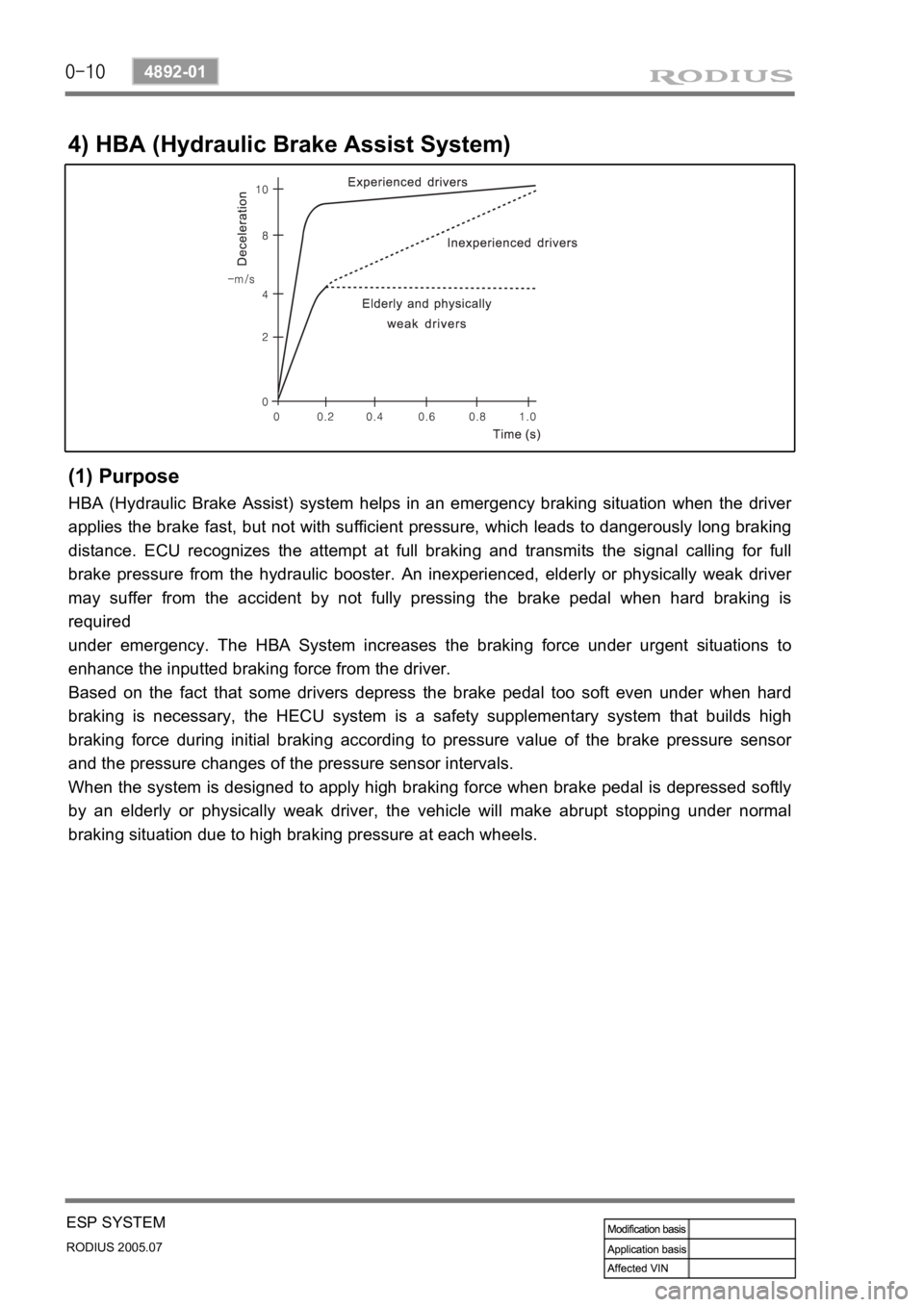
0-10
RODIUS 2005.07
4892-01
ESP SYSTEM
4) HBA (Hydraulic Brake Assist System)
(1) Purpose
HBA (Hydraulic Brake Assist) system helps in an emergency braking situation when the driver
applies the brake fast, but not with sufficient pressure, which leads to dangerously long braking
distance. ECU recognizes the attempt at full braking and transmits the signal calling for full
brake pressure from the hydraulic booster. An inexperienced, elderly or physically weak drive
r
may suffer from the accident by not fully pressing the brake pedal when hard braking is
required
under emergency. The HBA System increases the braking force under urgent situations to
enhance the inputted braking force from the driver.
Based on the fact that some drivers depress the brake pedal too soft even under when hard
braking is necessary, the HECU system is a safety supplementary system that builds high
braking force during initial braking according to pressure value of the brake pressure senso
r
and the pressure changes of the pressure sensor intervals.
When the system is designed to apply high braking force when brake pedal is depressed softly
by an elderly or physically weak driver, the vehicle will make abrupt stopping under normal
braking situation due to high braking pressure at each wheels.
Page 244 of 502
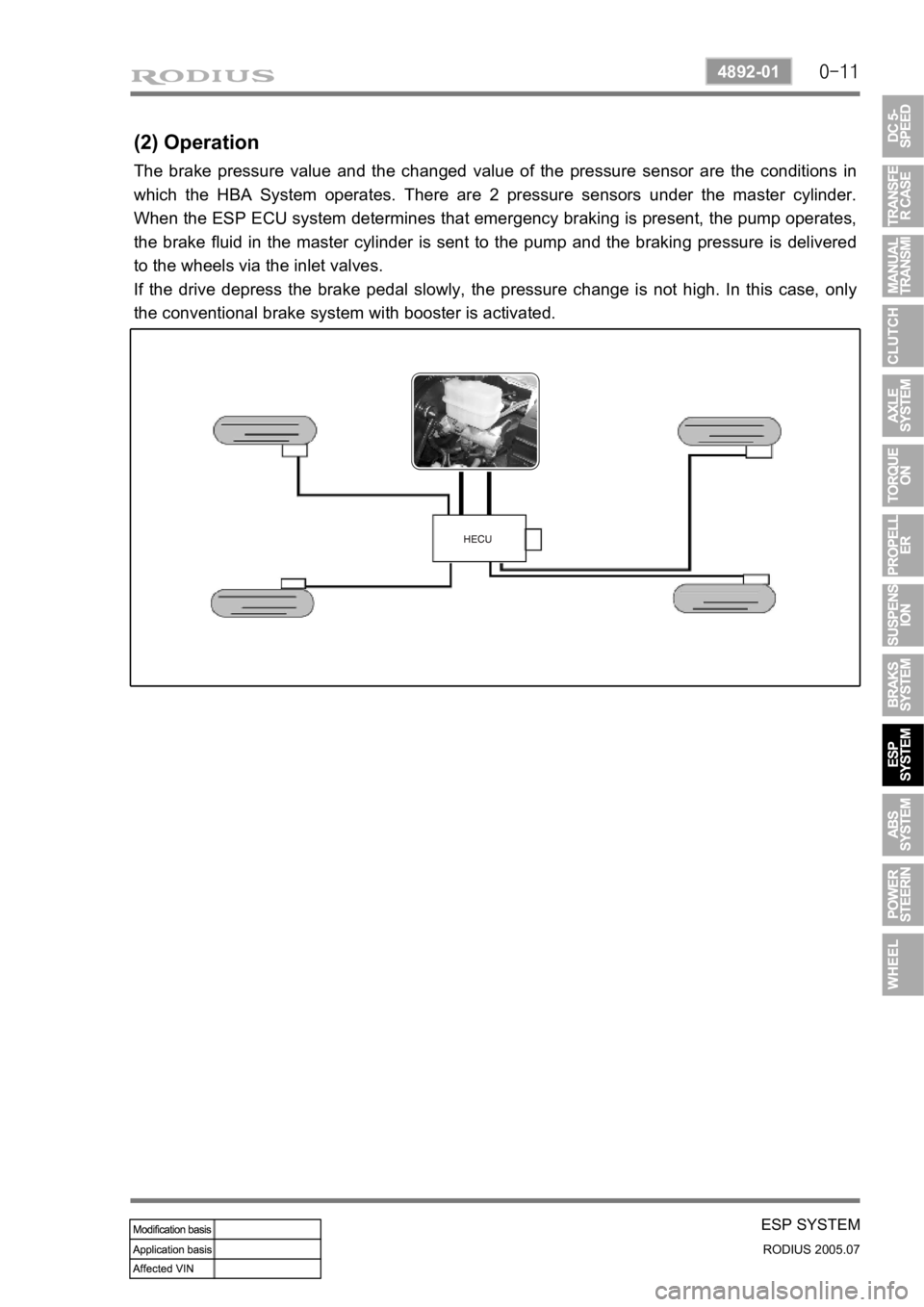
0-11
ESP SYSTEM
RODIUS 2005.07
4892-01
(2) Operation
The brake pressure value and the changed value of the pressure sensor are the conditions in
which the HBA System operates. There are 2 pressure sensors under the master cylinder.
When the ESP ECU system determines that emergency braking is present, the pump operates,
the brake fluid in the master cylinder is sent to the pump and the braking pressure is delivered
to the wheels via the inlet valves.
If the drive depress the brake pedal slowly, the pressure change is not high. In this case, only
the conventional brake system with booster is activated.
Page 247 of 502
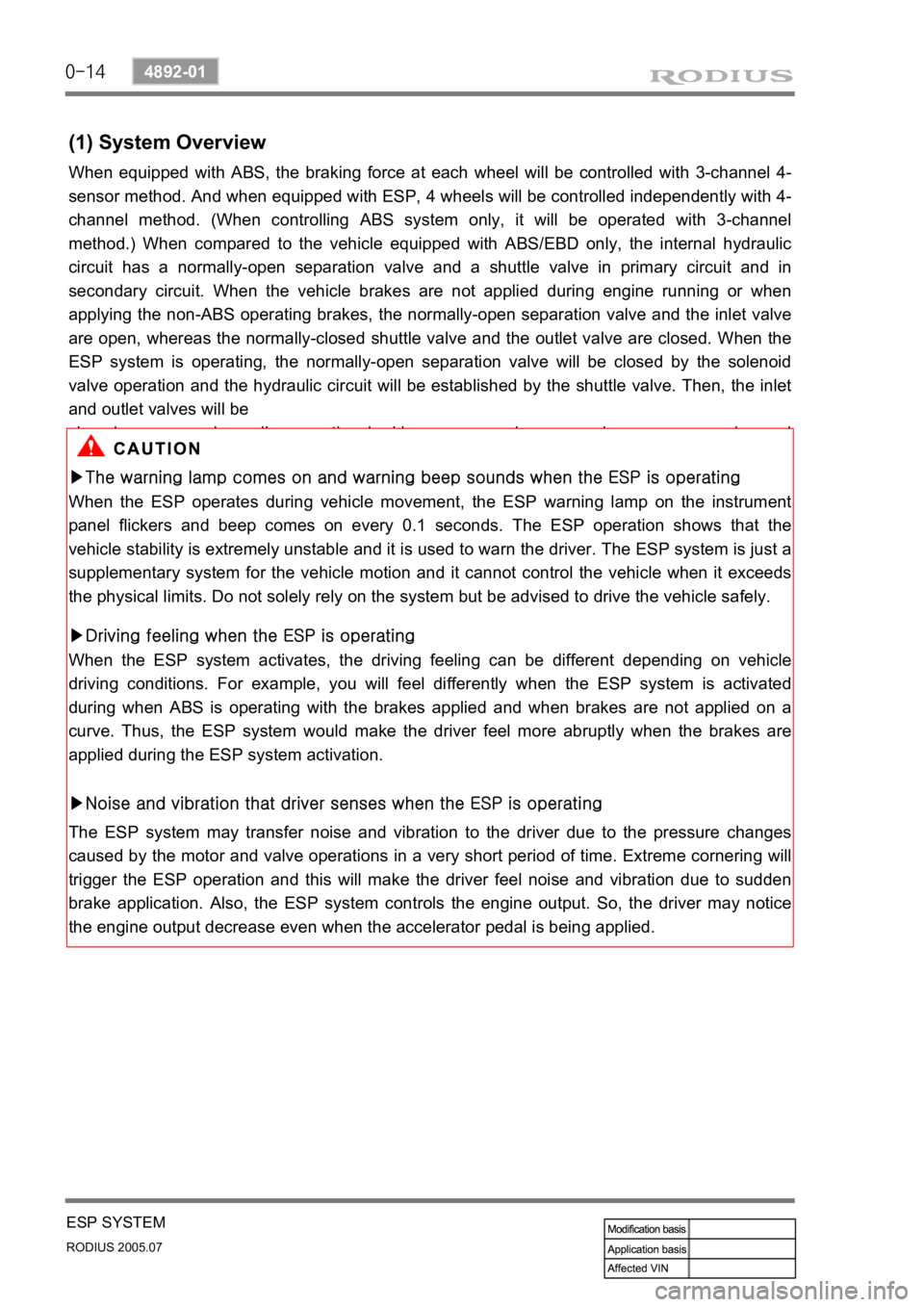
0-14
RODIUS 2005.07
4892-01
ESP SYSTEM
(1) System Overview
When equipped with ABS, the braking force at each wheel will be controlled with 3-channel 4-
sensor method. And when equipped with ESP, 4 wheels will be controlled independently with 4-
channel method. (When controlling ABS system only, it will be operated with 3-channel
method.) When compared to the vehicle equipped with ABS/EBD only, the internal hydraulic
circuit has a normally-open separation valve and a shuttle valve in primary circuit and in
secondary circuit. When the vehicle brakes are not applied during engine running or when
applying the non-ABS operating brakes, the normally-open separation valve and the inlet valve
are open, whereas the normally-closed shuttle valve and the outlet valve are closed. When the
ESP system is operating, the normally-open separation valve will be closed by the solenoid
valve operation and the hydraulic circuit will be established by the shuttle valve. Then, the inlet
and outlet valves will be
closed or open depending on the braking pressure increase, decrease or unchanged
conditions.
<0d96007b008f008c0047009e00880099009500900095008e004700930088009400970047008a00960094008c009a004700960095004700880095008b0047009e00880099009500900095008e00470089008c008c00970047009a0096009c0095008b009a00
47009e008f008c00950047009b008f008c0047006c007a0077> is operating
▶Driving feeling when the ESP is operating
<0d96007500960090009a008c004700880095008b0047009d0090008900990088009b0090009600950047009b008f0088009b0047008b00990090009d008c00990047009a008c0095009a008c009a0047009e008f008c00950047009b008f008c0047006c00
7a007700470090009a004700960097008c00990088009b0090>ng When the ESP operates during vehicle movement, the ESP warning lamp on the instrument
panel flickers and beep comes on every 0.1 seconds. The ESP operation shows that the
vehicle stability is extremely unstable and it is used to warn the driver. The ESP system is just a
supplementary system for the vehicle motion and it cannot control the vehicle when it exceeds
the physical limits. Do not solely rely on the system but be advised to drive the vehicle safely.
When the ESP system activates, the driving feeling can be different depending on vehicle
driving conditions. For example, you will feel differently when the ESP system is activated
during when ABS is operating with the brakes applied and when brakes are not applied on a
curve. Thus, the ESP system would make the driver feel more abruptly when the brakes are
applied during the ESP system activation.
The ESP system may transfer noise and vibration to the driver due to the pressure changes
caused by the motor and valve operations in a very short period of time. Extreme cornering will
trigger the ESP operation and this will make the driver feel noise and vibration due to sudden
brake application. Also, the ESP system controls the engine output. So, the driver may notice
the engine output decrease even when the accelerator pedal is being applied.
Page 252 of 502
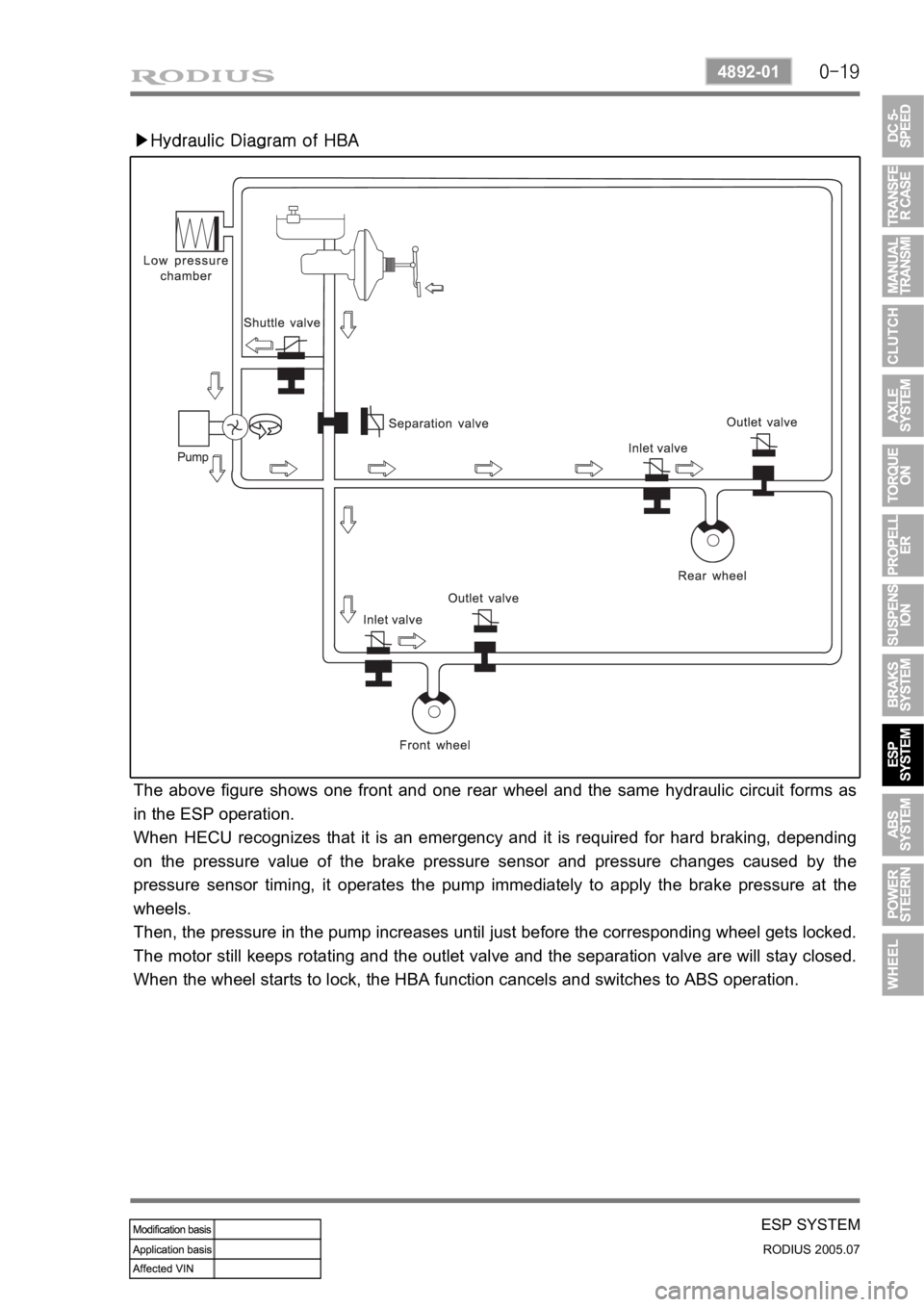
0-19
ESP SYSTEM
RODIUS 2005.07
4892-01
▶Hydraulic Diagram of HBA
The above figure shows one front and one rear wheel and the same hydraulic circuit forms as
in the ESP operation.
When HECU recognizes that it is an emergency and it is required for hard braking, depending
on the pressure value of the brake pressure sensor and pressure changes caused by the
pressure sensor timing, it operates the pump immediately to apply the brake pressure at the
wheels.
Then, the pressure in the pump increases until just before the corresponding wheel gets locked.
The motor still keeps rotating and the outlet valve and the separation valve are will stay closed.
When the wheel starts to lock, the HBA function cancels and switches to ABS operation.
Page 261 of 502

0-9
ABS SYSTEM
RODIUS 2005.07
4892-01
(3) Basic ABS Controls
Applications of the ABS control unit
The signals produced by the wheel sensors
are evaluated in the electronic control unit.
From the information received, the control
unit must first compute the following
variables:
- Wheel speed
- Reference speed
- Deceleration
- Slip
Reference speed ▶
The reference speed is the mean, I.e. average speed of all wheel speeds determined by simple
approximation.
Simplified ABS control ▶
If, during braking, one wheel speed deviates from the reference speed, the ABS control unit
attempts to correct that wheel speed by modulating the brake pressure until it again matches
the reference speed. When all four wheels tend to lock, all four wheels speeds suddenly
deviate from the previously determined reference speed. In that case, the control cycle is
initiated again in order to again correct the wheel speed by modulating the brake pressure.
Selector low control ▶
This control is used for regulating the brake pressure for rear axle during ABS operation. This
control uses lower adhesion coefficient to prevent the rear wheels from locking.